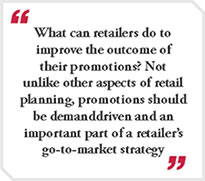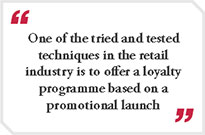 How to make money from grocery promotions
How to make money from grocery promotions
Discounting and repeated promotion campaigns hurt the retailer as well as the manufacturer / service provider with uncertain outcomes around consumer loyalty. What can retailers do in order that they manage this difficult and oftentimes contradictory landscape?
In India, we are witness to online marketplaces discounting and running sales promotion round the year. However, the competitive discounting and promotion cycles have taken the wind out of both the online marketplaces as well as offline retail stores.
Urban Indian consumers have voted with their feet and thronged online marketplaces while footfalls in offline retail outlets have shown a sharp decline especially during large festivals like Diwali. Some studies in the UK have shown that up to 58 per cent of UK grocery promotions – across 200 retail categories – are not making any money for FMCG brands as the supermarket price wars continue to put pressure on suppliers to discount products. A recently leaked report puts Uber’s marketing expenses at $541 million for an 18-month period starting in early 2014, with promotions and price rebates alone costing $129 million.
Clearly, discounting and repeated promotion campaigns hurt the retailer as well as the manufacturer / service provider with uncertain outcomes around consumer loyalty. What can retailers do in order that they manage this difficult and oftentimes contradictory landscape?

Spark consumers’ interest
 The normally applied principle on promotions is that once the consumer has tried the product or service, she is inclined to continue using the same. It is important to provide her the best possible experience so that the buying behaviour is sustained.
The normally applied principle on promotions is that once the consumer has tried the product or service, she is inclined to continue using the same. It is important to provide her the best possible experience so that the buying behaviour is sustained.
Companies today use either discounts or philanthropic objectives as part of their short term promotion policies in order to spark the consumer’s interest. Will she be interested in a discount on her next purchase or will the company automatically trigger a donation to her favourite charity on every purchase? These principles have been rarely, if ever, tested with rigorous experimentation and results.
A small field experiment conducted by INSEAD reveals some interesting insights.
- INSEAD recently executed a “field experiment” to study promotion take-up and subsequent taxi booking behaviour among groups of randomly selected customers that were sent different kinds of promotions4. The findings suggest the need to temper the expectations regarding what short-term promotions can achieve.
- Customers within each “treated” group received a text message containing a promotional code, different for different groups and valid for five days in all cases.
- Some of the customer groups received promotions whose redemption triggered a donation from the taxi company (at no extra cost to the passenger) to a relief fund for the 2015 Nepal earthquake (a later round of promotional texts used Singapore Cancer Society as the recipient to see whether a local charity would draw more participation). Several versions of the text message were sent, each stating a different donation amount from SGD 1 to 10. All redeemed donations were indeed furnished to the charities.
- Other customer groups got text messages with promotion codes good for a discount of up to SGD 10 off their next ride. INSEAD tracked not only how many customers took advantage of the promotions but also whether there was any discernible change in their purchases compared to their prior booking history, as well as those of a “control group” not receiving any promotions.
- On the whole, only about one per cent of the entire sample group took up any of the offers - not too unusual for take-up rates of SMS-based promotions What is perhaps more interesting is that the discount-linked promotions were redeemed at rates an order of magnitude greater than philanthropic ones of the corresponding amounts.
- When the INSEAD researchers compared promotional participation to the company’s pre-existing purchase data, they found that the promotions typically spurred extra bookings over and above those that would have been placed anyway. However, this effect did not persist and there was little evidence of a net increase in nonpromotional bookings following a promotion.
- Most intriguingly, the researchers found that participation in charity-linked promotions should be less sensitive to dollar amounts, compared to discount-linked promotions. The participation rate for the SGD10 donation was only double the SGD1 donation’s rate, while the SGD10 discount had 3.6 times as many redemptions as the SGD1 discount.
- Surprisingly, they found that even charity-linked promotions did not lead to increased taxi booking frequency in the weeks immediately following the promotion. Instead, just as with the discounts, the only significant difference in activity between the groups receiving a promotion and the control group was in the promotional ride itself.
The takeaway from this and other similar experiments is that one of the objectives of the promotion campaign – spark the customer’s interest – is met. Ad-hoc promotions – that don’t correlate with the retailer’s positioning and strategy don’t deliver against customer loyalty. However, the larger objective of sustaining the consumer’s interest is still not addressed adequately.
There is an abundance of literature available today on planning, timing, launch, duration, structuring and closure of promotion in the Indian retail industry. There is very little information available by way of correlating promotions and outcomes – which is a much more difficult problem to resolve. As in all other similar business problems, technology provides some direction.
Capturing consumers through technology
 Until recently, most retailers were focused on bringing systems on board that could help them with more critical aspects of planning – such as merchandising and inventory management.
Until recently, most retailers were focused on bringing systems on board that could help them with more critical aspects of planning – such as merchandising and inventory management.
Spreadsheets still serve as the tool of choice to help retailers create and execute promotional events and campaigns. Planning promotions in this manner has always been complex and an inexact science, but adding new online and social selling channels – such as Facebook, Twitter, Groupon, Deal find and many more – to the mix of more traditional methods like television and email has made this approach nearly impossible.
What can retailers do to improve the outcome of their promotions? Retailers today have the technology at their disposal to:
- Analyse how promotions performed in the past
- Take the cost of launching and sustaining promotions into consideration systematically
- Integrate promotional data into product assortments
- Identify customer demographics based on off take
- Integrate technologies pertaining to Geo Location Identification into the promotion
- Make better pricing decisions
- Align supply chains and replenishment execution
Taken together, the above span the entire spectrum of the consumer purchase cycle – from interest to buying and post purchase to loyalty. While technology provides an end-to-end solution, such a choice is rarely correct. Managers in the retail industry need to identify the specific issues with respect to promotions, establish the business response that they would like to provide to their customers and act on this agenda.
Rewarding the consumer for her loyalty
 One of the tried and tested techniques in the retail industry is to offer a loyalty programme based on a promotional launch. Credit card companies have perfected the art of offering a “zero subscription” credit card that accrues points at higher rates if the consumer uses their card. However, it is now widely accepted in the retail industry that the efficacy of such loyalty programmes are unclear.
One of the tried and tested techniques in the retail industry is to offer a loyalty programme based on a promotional launch. Credit card companies have perfected the art of offering a “zero subscription” credit card that accrues points at higher rates if the consumer uses their card. However, it is now widely accepted in the retail industry that the efficacy of such loyalty programmes are unclear.
Greater understanding of loyalty programme effectiveness demands a broader framework for analysing loyalty programme performance, along three key perspectives.
- a customer portfolio perspective can indicate the loyalty programme’s opposing effects on target versus bystander customers;
- a reward element perspective delineates the varying efficacy of its different reward benefits;
- a reward delivery perspective highlights how reward delivery either emphasises or diminishes the programme’s effects.
Typically the parameters that affect loyalty programme outcomes are:
- Customer gratitude, status, and unfairness represent positive and negative forces, mediating the loyalty programme’s impact on performance outcomes.
In three studies—two experimental and one field the results provide important insights for managers of loyalty programmes.
- First, findings underscore the importance of a customer portfolio perspective. For example, in an airline context with free services granted to target customers, at a ratio of 13 or more bystanders to 1 target, the bystander losses outweigh the target customer’s profits.
- Second, findings demonstrate the importance of a reward element perspective. For example, in a typical airline loyalty programme, although free services exert a strong positive effect on target customers, they affect bystanders only slightly negatively. Priority boarding instead confronts managers with a tough trade-off: It positively affects targets but strongly negatively affects bystanders.
- Third, findings reinforce the importance of a reward delivery perspective. For example, clearly communicating the rules of a loyalty programme helps decrease bystander customer perceptions of unfairness, but at the same time, it reduces the level of target customer gratitude.
Get more from your promotions
While promotions and discounts are an integral part of life in the retail industry, sustainability over the longer term has been a matter of debate for several years. In the days ahead, a more systematic approach to create targeted promotions using consumer data, buying behaviour and aligned organisational infrastructure can create sustainable advantages for the retailers adopting these practices into their operations strategy.
Technology provides some levers to answer the age-old questions in retail – what does my customer want? However, the planning and usage of these tools is still in the hands of the managers in the industry.
The author is Managing Principal – Indian Operations, CGN & Associates India Pvt Ltd



.png?width=203&name=CGN_Tagline1%20(1).png)